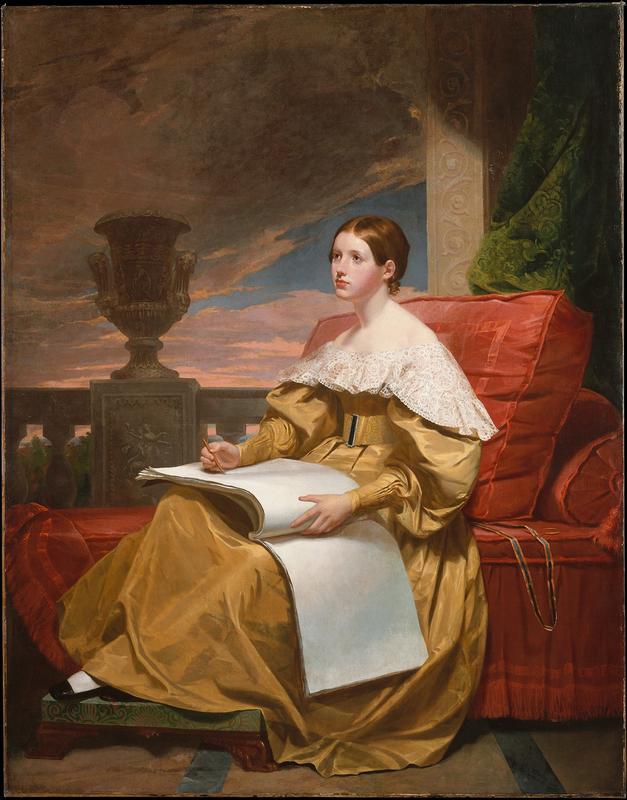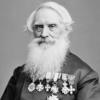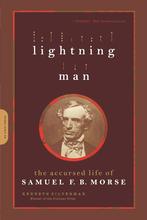More about Susan Walker Morse (The Muse)
- All
- Info
- Shop

Contributor
Samuel Morse’s Susan Walker Morse (The Muse) sits at the intersection of painting, inventing, poverty, and true love.
If Samuel Morse’s name sounds familiar to you, it’s probably because you know him as the inventor of the electric telegraph. You know, that thing that used to send coded messages through electric currents that we dubbed Morse Code? If his name doesn’t sound familiar to you at all, then you’re probably in your 20s and have no idea what a telegraph or Morse Code is. It’s not your fault. Blame our educational system. Whatever your level of knowledge is on Morse, all you really need to know is that before he was a famous inventor, he was a starving artist that was as talented as he was smart. He just never got the same level of recognition for his art as he eventually would for his inventions.
Morse’s painting The Muse, is a portrait of his daughter Susan Walker Morse. She was about sixteen or seventeen at the time. Morse worked on the painting from 1835 to 1837, roughly the same time he was working on the creation of the telegraph that would change his life and the trajectory of human history forever.
The portrait is a true honor from a father who clearly loves his daughter. Susan Walker Morse is depicted with a sketchbook, a pencil, and a face scanning for what one would assume to be inspiration. She seems content, dressed nicely and surrounded by comfortable scenery. But in reality, that wasn’t the case. Even though Morse’s life was about to take a turn for the better, it was at its lowest point during the creation of this painting. Morse was literally starving. He held an unpaid position at New York University as the professor of literature of the arts and design. It was in his jumbled room in Washington Square where the painting was realized.
What makes all of this a really sweet gift to his daughter was, despite the fact that he was virtually impoverished and couldn’t provide much for her in her waning teenage years, he was able to scrounge up the energy to pay homage to his love for her by immortalizing her in a portrait. And it doesn’t stop there. When you take into consideration that they were poor, you come to the conclusion that the fancy dress and decorated background were included as a way to transport his daughter from the drab and cluttered life she was accustomed to, to a more desirable fantasy. If that’s not love, I don’t know what is.
Morse’s The Muse was his last painting painted for public consumption. After its completion, he shifted his attention entirely over to the invention of the telegraph. It’s hard to know if Morse would have ever reached the heights that he was striving for as an artist. But I think it’s safe to say that his contribution as an inventor was something that the world needed. Either way, the completion of this work marks the beginning of the next phase of his life, where he was undoubtedly able to give Susan Walker Morse everything he had manifested for her in this painting, if not more.
Sources
- Britannica. Samuel F.B. Morse. Accessed May 16, 2020. https://www.britannica.com/biography/Samuel-F-B-Morse
- Caldwell, John, Oswaldo R. Roque, and Dale T. Johnson. American Paintings in The Metropolitan Museum of Art: A Catalogue of Works by Artists Born by 1815. Vol. 1. Metropolitan Museum of Art, 1994, 379-380. https://books.google.com/books?id=dYdWBwAAQBAJ&pg
- Maranzani, Barbara. “6 Things You May Not Know About Samuel Morse.” History.com. August 22, 2018. https://www.history.com/news/six-things-you-may-not-know-about-samuel-m…
- Ten Eyck Gardner, Albert. “The Metropolitan Museum of Art Bulletin New Series Vol. 4”, No. 10 (June 1946): 262-268 https://www.jstor.org/stable/3257203?read-now=1&seq=7#page_scan_tab_con…












